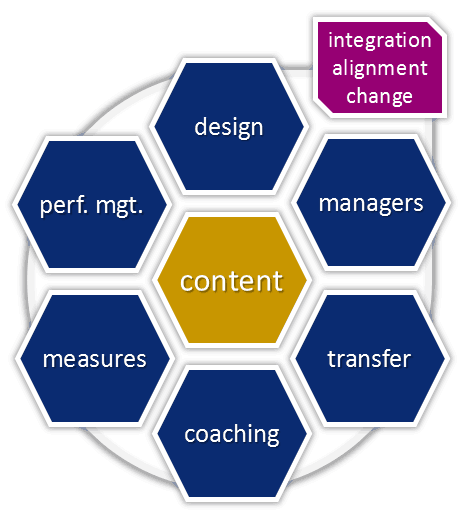 Sales onboarding continues to get a lot of attention, as more organizations seek new ways to ramp up reps faster and reach higher levels of productivity for new hires.
Sales onboarding continues to get a lot of attention, as more organizations seek new ways to ramp up reps faster and reach higher levels of productivity for new hires.
Most onboarding strategies I read about are good, but I rarely see anything that’s truly differentiating, or that will significantly move the needle. I’ve developed a method that’s been used in multiple companies and has produced great results. (See slide 3 for examples.)
The secret is combining these 7 things and doing them well:
- Define the competencies for success
- Hire right
- Use top-producer practices as the content for training (training content?)
- Set performance milestones
- Focus on need-to-know by milestone
- Use chunk | sequence | layer to break up your curriculum by milestone
- Execute with discipline supported by an Effective Learning System
Define the Competencies for Sales Success
A systems approach can help average performers produce at above-average levels, but no amount of training will help someone succeed if they don’t have the mindset, competencies, skills and behaviors needed for sales success at your company. These are the foundation for everything else a salesperson does so spend the time to get this right. This fuels hiring and training, and can be done at the same time as a Top-Producer Analysis (which is one way to identify the competencies you want to hire and replicate.)
Hire Right
This is always the first step of effective sales onboarding.
Your competency analysis and Top-Producer Analysis can tell you a lot about who to hire. I recommend a combination of validated psychometric assessments, behavioral interviewing, simulations, past success validation, plus background and reference checks. The experts at Peak Sales Recruiting can share much more about this and support you through the process.
Use Top-Producer Practices as the Content for Training
When you study top producers, identify those who have been primarily responsible for their success (meaning, they didn’t just inherit a great territory or have extraordinary assistance in landing one massive account) and find the replicable and differentiating behaviors that separate them from middle and bottom producers.
Compare the mindsets, knowledge, skills, competencies and best practices of top-producers to those in the middle bucket, and then create a list of what middle producers should continue, start and stop, to help them get better results. Then, work this content into your sales onboarding, as described below.
Set Performance Milestones
Set performance expectations for your new hires.
- For a short sales cycle and a relatively simple sale, you might consider first sale, first month at quota, and first quarter at quota.
- For a more complex or longer sale and sales cycles, you’ll need to determine lead indicators that matter, such as activity metrics, opportunity movement in your pipeline, and number of viable deals generated, until you get to the lag results.
But in either case, think this through, benchmark past results as a starting point, set the milestones, and measure and report progress toward goals for all new hires.
Focus on Need-to-Know by Milestone
First, you need to have the difficult, prioritization conversations and determine what reps really NEED to know to hit each of your milestones.
Then, you need to use a technique known to instructional designers as Chunk, Sequence and Layer: Chunk like topics and content together, sequence them in a logical order based on business process and workflow (how the rep will actually do their job), and once they learn one thing, and you can validate the learning through assessment/tests, discussion or skill validation, layer something else on top of it.
Keep this going until the rep has learned everything they need to know and do to achieve the first milestone. Then track their progress toward the first milestone, while you start to ramp them toward milestone 2. Rinse and repeat, working your way through however many performance milestones you’ve set.
Execute with Discipline
The success of any sales training initiative, including onboarding, will be determined by how well you execute. I recommend what I call an Effective Learning System.
Content
Start with content that will get results in the real world. Base your training content on top-producer practices whenever possible.
Design
If you start with the right content, you still need to design your training well so people learn and have plenty of time for skill practice, feedback and applying that feedback. I prefer using a blended curriculum where you can flip the classroom training to be exercises, activities and role plays, with plenty of feedback and redoing.
Manager Engagement
If you’re training sales reps, their managers need to buy in to what’s being taught and need to be trained on it, too. That way, they can reinforce what is taught. They must be trained how to coach their sales reps to mastery.
Transfer and Coaching to Mastery
For transfer and coaching to mastery, you can create assessments to use over time, or use a learning reinforcement tool like Qstream. Through this type of tool, you can create forms and job aids and other performance support. Sales managers can inspect what they expect, as well as coach the reps over time. Don’t expect the training to stick without some purposeful plans for reinforcement and using the skills on the job.
Measures
What gets measured gets done. It always helps to have metrics and measures in place to gauge how well it’s working and whether your sales reps are doing what was taught, and if it’s getting better results for them.
Performance Management
This is a larger, separate effort, but all of this should be wrapped into your sales reps’ performance plans (as well as your managers’), to reinforce and drive the behaviors you want to see.
Integration | Alignment | Change Management
If you expect behavior change, you need alignment around the expectations of what trainees should be doing and should treat the entire initiative like a change management project. Organizational behavior rarely changes without a well-designed and well-implemented plan.
Combine this concept of an effective learning system with the logic above when creating an effective Sales Onboarding program, and you will get results like you never thought possible.
relpost-thumb-wrapper
close relpost-thumb-wrapper
Latest posts by Eliot Burdett (see all)
- 31 Must-Know Sales Follow-Up Statistics for 2024 Success – December 21, 2023
- 7 Success Characteristics That Define Top Performers – December 19, 2023
- 5 Reasons Your Top Employees Quit (Stop Doing This to Stop Them Leaving) – December 14, 2023

 Sales onboarding continues to get a lot of attention, as more organizations seek new ways to ramp up reps faster and reach higher levels of productivity for new hires.
Sales onboarding continues to get a lot of attention, as more organizations seek new ways to ramp up reps faster and reach higher levels of productivity for new hires.



